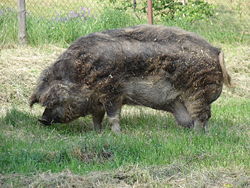- Mangalitsa
-
Mangalitsa
A swallow bellied Mangalitsa sow in the gardens of the Franciscan monastery at Kadaň, Czech RepublicConservation status rare breed Other names - Mangalitza
- Mangalica
Country of origin Hungary Nicknames Curly-hair hog Pig (Sus scrofa domesticus.)  Piglets of Mangalitza pig (approximately one month old) in Münsterland, Germany
Piglets of Mangalitza pig (approximately one month old) in Münsterland, Germany
Mangalitsa (US spelling), Mangalitza (UK spelling) or Mangalica (original Hungarian spelling) is a name for three breeds of pig grown especially in Hungary and the Balkans known also as a curly-hair hog. It belongs to European unimproved lard-type breeds (as well as Iberian Black and Alentejana pigs) that are descended directly from wild boar populations.[1] The Mangalitsa pig is unusual as it grows a hairy 'fleece', akin to that of a sheep. The only other pig breed noted for having a long coat is the now extinct Lincolnshire Curly Coat of England. The Mangalitsa was formerly bred as a lard pig, and animals were large and round. Because of the drop in demand for lard, the breed's popularity has declined and it is now regarded as a "rare breed".[2]
Contents
Name
Serbian language reformer Vuk Stefanović Karadžić gave the breed its name Mangalica, which describes it as a 'hog with a lot of lard'.[3]
It is referred to as the "Mangalitza" in the United Kingdom and the "Mangalitsa" in the United States.
History
The blonde Mangalitsa was developed from older hardy types of Hungarian pig (Bakonyi and Szalontai) crossed with the Šumadija breed of Serbian origin (1833)[4] (and later others like Alföldi or Croatian Šiška and Syrmien).[5] The development took place in Hungary in the early 19th century.[4] The new quick-growing "fat-type" hog did not require any special care, so became very popular in Hungary. In 1927 the National Society of Fat-Type Hog Breeders (Mangalicatenyésztők Országos Egyesülete) was established, with the objective of improving the breed.[4] Mangalitsa was the most prominent swine breed in the region until 1950 (there were 30,000 of them in Hungary in 1943).[4] Since then the popularity as well as the population of Mangalitsa have been decreasing, with the rising availability of food from further away and refrigeration.[6] Nowadays, the keeping of Mangalicas has become a popular hobby.[4] There are currently slightly over 7000 Mangalitsa sows in Hungary, producing cca. 60000 porkers a year.[7]
In March 2006, 17 Mangalitza were imported from Austria into the UK. These are registered with the British Pig Association (BPA) and the pedigrees are being maintained on the BPA Mangalitza Herd Book. Three of the animals are at Tropical Wings zoo in Essex.[8]
The Swallow-bellied Mangalitsa breed was produced by crossing the blonde Mangalitza and the Black(which has gone extinct).[4]
In 2007, Wooly Pigs, an American company, imported a herd of 24 Swallow-belly Mangalitsa gilts and boars to the USA.
Husbandry
The Mangalitsa produces too little lean meat so it has been gradually replaced by modern domestic breeds. It is usually fed with a mix of wild pasture, supplemented with potatoes and pumpkins produced on the farm.[4]
The primary product made from this pig is sausage, usually packed in the pig's duodenum. The minced meat is seasoned with salt, pepper, sweet paprika, and other spices. It is then eaten in slices with pickled vegetables. The pork is also served braised with sauerkraut, potatoes, and stuffed peppers as a side dish. Farmers also produce smoked hams.[9] The fresh meat tastes strong and juicy; the suckling pigs are much preferred for their good fresh meat qualities.[10]
In the UK, the breed is kept free-range, fed on standard Sow and Weaner Pellets. The higher quality and protein levels of this food results in a slightly larger stockier pig.
In Hungary, most Mangalitsa pigs are raised semi-intensively or intensively.
Mangalitzas will happily rear their young (who are born stripes like wild boars) in outside arks all year round without the need for additional heat and light.
Killing weight (for meat production) is generally achieved beyond 12 months of age,[11] much longer and the additional fat gained becomes too excessive for the UK market.
Meat from Mangalitsa can be easily found in Hungary, as Hungarian farmers produce about 60.000 animals each year.[12]
Breeds
There are three Mangalitsa breeds: Blonde, Swallow-bellied and Red. They all have the same behavior; the only difference is the colour. The Blonde Mangalitsa is blonde, the Swallow-bellied (originally produced by crossing the Blonde Mangalitsa with the extinct Black Mangalitsa)[4] has a blonde belly and feet with a black body, and the red (produced by crossing the Blonde Mangalitsa with the Szalonta breed)[4] is ginger. Other breeds (black, wolf, and baris) have died out as pure-bred forms, though their reconstruction from selective breeding of mixed varieties is being debated in Hungary.[4]
References
- ^ "Heath Putnam: Wooly Pigs". woolypigs.com. http://woolypigs.com/_breeds.html. (English)
- ^ Alderson, R (1994). Rare Breeds. Laurence King Publishing. ISBN 1856690520.
- ^ "B92 - Život - Teorija o Svačemu - Povratak dugodlakih lutalica". b92.net. http://www.b92.net/zivot/teorija.php?nav_id=288491. (Serbian)
- ^ a b c d e f g h i j Dr. Radnóczi László. "The Hungarian Mangalica". agroservice.hu. http://www.agroservice.hu/mangainfo1.htm. (English)
- ^ "Interessensgemeinschaft der Wollschweinzüchter Österreichs". home.tele2.at. http://home.tele2.at/wsnaweb/IGWOE/. (German)
- ^ "Salvan breed of pig-like Hungarian Iberian – translated article". translate.google.com. http://translate.google.com/translate?u=http%3A%2F%2Fmensual.prensa.com%2Fmensual%2Fcontenido%2F2008%2F02%2F03%2Fuhora%2Fvarie_2008020312503394.shtml&langpair=es%7Cen&hl=en&ie=UTF-8&oe=UTF-8&prev=%2Fl. (English)
- ^ http://www.origo.hu/itthon/20100421-megjelent-a-mangalica-angliaban-megmentett-hobbiallat-vagy-regi-magyar-fajta.html
- ^ "Rare pigs are mistaken for sheep". BBC News. 19 April 2010. http://news.bbc.co.uk/cbbcnews/hi/newsid_8620000/newsid_8629800/8629871.stm.
- ^ "The Slow Food Foundation for Biodiversity". fondazioneslowfood.it. http://www.fondazioneslowfood.it/eng/presidi/dettaglio.lasso?cod=214. (English)
- ^ "Breeds of Livestock – Switzerland". ansi.okstate.edu. http://www.ansi.okstate.edu/breeds/swine/.
- ^ Sanders, Michael S. (1 April 2009). "An Old Breed of Hungarian Pig Is Back in Favor". The New York Times. http://www.nytimes.com/2009/04/01/dining/01pigs.html?em.
- ^ "Hungarian mangalica is introduced in the U.K". origo.hu. http://www.origo.hu/itthon/20100421-megjelent-a-mangalica-angliaban-megmentett-hobbiallat-vagy-regi-magyar-fajta.html. (Hungarian)
External links
Categories:- Pig breeds
- Animal breeds originating in Hungary
Wikimedia Foundation. 2010.


